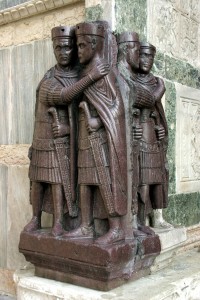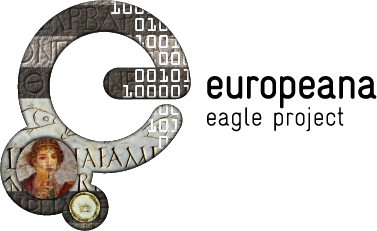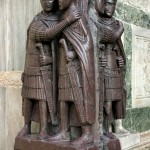Honorific inscriptions to Roman emperors use standard formulae to praise the virtues of a good ruler. This is particularly true in the tetrarchic period (of the late 3rd/ early 4th century); however, what might seem dull at first sight, can prove very interesting when a destroyed text needed to be restored. A base found in Thamugadi, in the province of Numidia (now north-western Algeria) and last recorded on the forum of that city, is a telling example that a statue is more than just the inscription carved on it, and that it can reveal more information than are given by the words themselves (LSA 2373).
The base is inscribed on two opposite sides. One of the inscriptions was erased at a certain point in Antiquity, but remains partly legible. The other inscription is undamaged. Thanks to the uniformity of the epigraphic formula, the erased inscription can with confidence be restored to have once read
Galerio Valerio Maximiano, nobilissimo Caesari, res publica coloniae Thamugadensium, devota numini maiestatique eius – ‘To Galerius Valerius Maximianus, most noble Caesar; the community of the colony of the Thamugadi, devoted to his divine spirit and majesty, set this up.’
The honoured emperor, Caius Galerius Valerius Maximianus (to give him his full name; ‘Galerius Valerius Maximianus’ in our inscription), is now normally known as ‘Galerius’. He was one of the Tetrarchs (‘Four Rulers’), the imperial college established by Diocletian (emperor 284-305). It was one of the most striking features of this system that aptitude, not birth, should determine who ruled. Galerius held the lower rank of Caesar from 293-305, then advanced to the senior rank of Augustus in 305; he died in 311. Our inscription styles him ‘most noble Caesar’, using the common epithet of the period for the Caesars; this enables us to date the inscription firmly to the years 293/305.

Porphyry statues of emperors, probably of First Tetrarchy (293-305). From Constantinople, now Venice, San Marco
The system of the tetrarchy was a response to the crisis the empire had faced in the 3rd century. The political and bureaucratic integration of the huge area, and the constant menace to the borders, were its main challenges. In their epigraphic representation, as well as in their imagery, the Tetrarchs propagated the ideal of imperial unity. The most famous example of this is the four porphyry statues now in Venice, which show the four emperors embracing each other, all clad in the same way, and their faces assimilated to an extent that makes it impossible for us to tell them apart. Accordingly, we may assume that our inscription (and its related statue) was once accompanied by similar ones to Galerius’ imperial colleagues.
However imperial unanimity did not last, and Africa experienced many troubles in the years following the retirement of Diocletian and Maximian. In 306-8 it was ruled by Maxentius, son of Maximian (and famous for the impressive basilica he built on Rome’s Forum); Maxentius had seized the throne and survived repeated attempts to depose him by Galerius, the legitimate emperor. Our base is witness to how the inhabitants of Thamugadi were eager to express their loyalty to Maxentius by defacing the memory of his rival Galerius. However, after the defeat of Maxentius by Constantine in 312, they restored the memory of Galerius, but now, after his death in 311, with a dedication to him as ‘the divine Galerius’. This dedication was probably made soon after Maxentius’ fall, as the citizens of Thamugadi once more aligned their statuary to meet the demands of contemporary politics.

